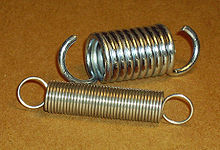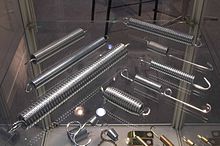Tension spring
Tension spring is the common name for a helical tension spring . Tension springs are made of round wire with no distance between the windings (pitch S W = wire diameter d ) helically wound or wound torsion springs that are subjected to tensile stress.
function
Extension springs store and transmit forces through changes in shape. The spring constant can be changed via the spring geometry and material selection . The tension spring is loaded by pulling the ends apart. The force is introduced via eyelets or connection elements on the spring ends. The stored energy is partially released again when the spring is pulled together.
Designs
Extension springs generally have a cylindrical design. The geometry of the spring body can also be designed to be conical. Profile wires and non-cylindrical designs are used in special cases.
Eyelet shapes and connection elements
The most common eyelet shapes and connection elements are specified in DIN 2097 :
- German eyelets (various designs)
- Hook eyes (dimensions and design variable)
- English eyelet
- rolled up hooks or threaded bolts
- Screw-in pieces
application
Extension springs are used in many areas of mechanical engineering, e.g. B. in:
- Vehicle construction (e.g. return spring in drum brakes)
- Plant and device construction (e.g. in relays)
- Body construction (e.g. on agricultural machinery and construction vehicles)
- Mechanisms (e.g. in seating furniture, locks, catches, pull-up mechanisms of gramophones )
Additional tension springs are used especially in cars with leaf springs such as B. built-in mobile homes, pick-ups or vans to counteract problems such as rolling in curves, strong side sensitivity, sagging leaf springs, difficult braking, problems keeping track, poor steering control, stubborn suspension, weight shift when cornering and heavy rear-heaviness. This is a mechanical spring system that is mounted between the center of the rear axle and the rear eye of the leaf or parabolic spring. The tension spring is installed parallel to the spring leaf with a given so-called “pre-tensioning”. In this way, every load on the leaf spring is recognized and the identification of the leaf spring is tightened and reinforced without preventing or blocking the suspension. The driving behavior is firmer, the driving comfort is maintained.
Materials and their standardization
Suitable and frequently used materials are spring steels :
- EN 10270-1 Patented drawn, unalloyed spring steel wire
- EN 10270-2 Oil tempered spring steel wire
- EN 10270-3 Stainless spring steel wire
Parameters
Selection of some parameters:
- d wire diameter in mm
- D Mean coil diameter in mm
- L 0 Length of the unloaded spring measured between the inner edge of the eyelet in mm
- n Number of resilient coils
- m (eye) hook opening width in mm
standardization
- DIN 2097 Cylindrical coil springs made of round wires; Quality regulations for cold-formed tension springs , current edition 1973-05
- DIN EN 13906-2 Cylindrical coil springs made of round wires and rods - Calculation and construction - Part 2: Tension springs , current edition EN 13906-2: 2001
Mainspring in clocks
The term “ tension spring” in the area of clock springs is misleading, albeit for historical reasons, because it comes from “winding” when pulling up the weight of old tower or grandfather clocks. It is actually a spiral spring that is subjected to bending stress and is therefore a spiral spring. The so-called mainspring in watches is a metal spring that is inserted in the barrel . This stores the supplied energy either by automatic winding or by manual winding.
Web links
- Tension spring, technical drawing of NH springs (PDF file; 1.2 MB)
Individual evidence
- ↑ http://www.sektionaltore.com/lexikon/lexikonv-z.htm
- ↑ Hans Jendritzki : From the tension spring drive. In: Writings of the Friends of Age Clocks. Issue 21, Ulm 1982, pp. 71-80.
- ↑ Small watch lexicon from AZ ( Memento from March 28, 2009 in the Internet Archive )

